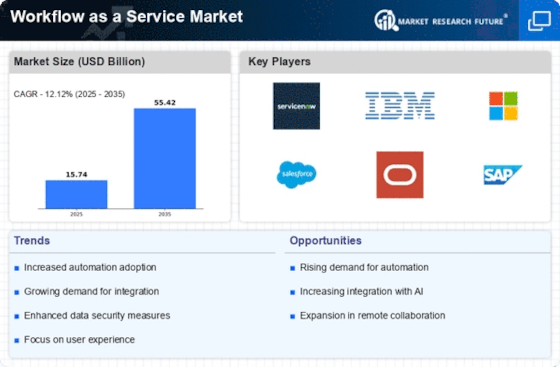Rising Adoption of Cloud Solutions
The Workflow as a Service Market is experiencing a notable increase in the adoption of cloud-based solutions. Organizations are increasingly migrating their operations to the cloud to enhance flexibility and scalability. According to recent data, the cloud services market is projected to reach a valuation of over 800 billion dollars by 2025. This shift is driven by the need for businesses to streamline processes and reduce operational costs. As companies seek to optimize their workflows, the demand for Workflow as a Service solutions is likely to grow, enabling them to leverage cloud capabilities for improved efficiency and collaboration. The integration of cloud technologies allows for real-time data access and seamless communication, which are essential for modern business operations.
Emphasis on Automation and Efficiency
In the Workflow as a Service Market, there is a pronounced emphasis on automation as organizations strive to enhance operational efficiency. Automation technologies, such as robotic process automation (RPA), are being integrated into workflows to minimize manual intervention and reduce errors. Recent studies indicate that businesses implementing automation can achieve up to a 30% increase in productivity. This trend is compelling organizations to adopt Workflow as a Service solutions that facilitate automated processes, thereby allowing employees to focus on higher-value tasks. The potential for significant cost savings and improved accuracy makes automation a key driver in the Workflow as a Service Market, as companies seek to remain competitive in an increasingly digital landscape.
Demand for Enhanced Collaboration Tools
The Workflow as a Service Market is experiencing a surge in demand for enhanced collaboration tools as organizations adapt to evolving work environments. The rise of remote work has necessitated the development of solutions that facilitate seamless communication and collaboration among distributed teams. Recent surveys indicate that over 70% of employees prefer flexible work arrangements, prompting businesses to invest in Workflow as a Service solutions that support collaborative efforts. These tools enable real-time document sharing, project management, and communication, fostering a more connected workforce. As companies recognize the importance of collaboration in driving innovation and productivity, the demand for Workflow as a Service solutions that enhance teamwork is likely to continue to grow.
Growing Need for Compliance and Security
The Workflow as a Service Market is witnessing a growing need for compliance and security measures as organizations face increasing regulatory pressures. With data breaches and cyber threats on the rise, businesses are prioritizing secure workflow solutions that ensure data integrity and compliance with industry standards. The market for cybersecurity solutions is expected to exceed 300 billion dollars by 2025, reflecting the urgency for robust security frameworks. Workflow as a Service providers are responding by incorporating advanced security features, such as encryption and access controls, into their offerings. This focus on compliance and security not only protects sensitive information but also builds trust with clients and stakeholders, making it a critical driver in the Workflow as a Service Market.
Shift Towards Data-Driven Decision Making
In the Workflow as a Service Market, there is a marked shift towards data-driven decision making as organizations seek to leverage analytics for improved outcomes. The ability to collect and analyze data in real-time allows businesses to make informed decisions that enhance operational efficiency. According to industry reports, companies that utilize data analytics are 5 times more likely to make faster decisions than their competitors. This trend is driving the adoption of Workflow as a Service solutions that integrate data analytics capabilities, enabling organizations to optimize their workflows based on actionable insights. As the importance of data in strategic planning becomes increasingly recognized, the demand for Workflow as a Service solutions that support data-driven approaches is expected to rise.


















Leave a Comment